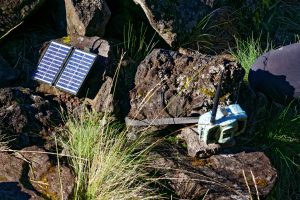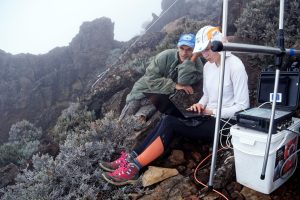The 2016-2017 season: Assessment of field actions regarding the monitoring of the Barau Petrel’s colonies.
To save a species, one must know it. Each breeding season of the Barau petrel, the LIFE+ Pétrel team and its partners work on understanding this species, whether on the field, in the laboratory or at the office.
300: This is the number of days that were spent on field missions by the LIFE+ Pétrel agents in 2016. This being 42 days more than in 2015. The missions are divided between the gathering of information on the Barau Petrel, the search for the Mascarene petrel, the control of invasive alien species, chumming, etc…
But what do the field agents do regarding the understanding of the species?
The agents regularly control specific burrows on well-known colonies of the Barau petrels. Thus, on the colonies of the Grand Bénare and of the Piton des Neiges, 269 burrows were monitored (1) regularly between the month of November 2016 and March 2017.
Thanks to this monitoring, we estimate that 60% of breeding couples who laid an egg were successful in raising a chick. These field monitorings give us an understanding of the colony. This year, only 58 adults without rings(2) were found in the colonies.
These monitoring operations were initiated in 2004. The teams began ringing 26 fledglings before their first flights from the colony. Three to six years later, these birds were found in the same colony. During the 2016-2017 season, 80% of the Barau petrels who were monitored were already known. This is an illustration of the long-term endeavours undertaken during the last 13 years. Great hope for the survival of this species!
The Barau petrel’s behaviour within their colony during breeding season was studied by Masters degree student Solenn Boucher during her placement year. Her internship goal was to understand the behaviour of the petrel during that time of year and to know more about their life in general. For example, enabling us to know when they are most vulnerable to cats and rats. For this, two methods were used:
-Infra-red cameras: cameras were set up at the entrance of the burrows. They took pictures and films each time they detected movement. These images show the petrels’ comings and goings, the partner parent’s incubating shifts, the fledgelings building their wing muscles (video below) and the presence of predators.
VHF tags: a radio wave emitter placed on the birds. An antenna picks up the signals sent by the device, allowing us to know the duration of the absence or presence of the birds on their colonies, the hours of nocturnal activity as well as the type of activity (flying or on the ground), thus allowing us to determine their vulnerability.
We’re still processing the information collected.
(1) Monitoring a colony entails regularly surveying key moments of the petrel’s life cycle. The first check ups occur soon after the egg-laying to know the identity of the first incubating male (by reading its ring). Then, 15 days later, the second check ups occur to know the identity of the incubating female. The third mission comes right before the fledgling’s first flight: they are then ringed in the hope of seeing them again later and being able to determine the various aspects of their lives: age of first reproduction, age of first return to colony, etc.)
(2) the ring allow us to distinguish each individual petrel thanks to a unique coded number
Pictures : Stéphane Michel et Solenn Boucher




